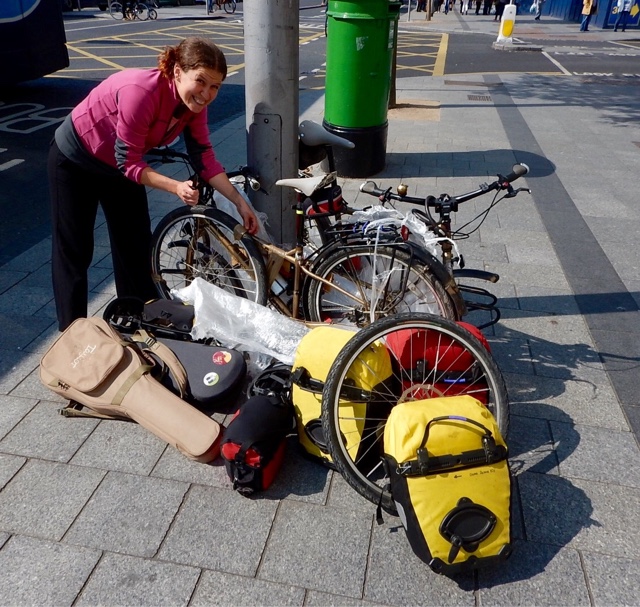We left rainy Spain on Wednesday morning, and headed to sunny Ireland! (Wait, what?) A short flight later we were all of a sudden in a place where people speak English and drive on the left side of the road! We're always amazed at the shift in cultures that happens over just a short distance!
We loaded the bikes on a bus from the airport to the city, spilled out all of our worldly possessions onto the Dublin sidewalk, cut open the shrink wrap on the bikes, and put the pieces back together.
We paused for a moment when we realized that we had been here before. Back in January. When the weather was terrible. And now we're back, the weather is beautiful, and it's nice to come to a place we know a bit. Not quite like "coming home," but for these two nomads it's as close to coming home as we get!
The ball of shrink wrap (bottom right in the photo above) was impressive! (Or, if one considers the amount of plastic that was used only briefly and then discarded, it was rather depressing...)
The scuplture above is located in the Rembrance Garden- dedicated to those who lost their lives in the fight for Irish freedom.
We had arrived in a proud and festive Dublin. As the city is celebrating the 100th anniversary of the 1916 Easter Rising, its streets and buildings are decorated with many posters & informative banners about the Rising and Irish independence. There are dozens of commemorative exhibits throughout the city and we learned a great deal about Irish history during our stay.
The Rising began on Monday of the Easter holiday of 1916, and went on for nearly a week during which many buildings in Dublin were destroyed and the lives of many, both Irish and English were lost. Although the Rising did not directly result in independence for Ireland, it set the stage for it. Ironically, at the time, the 1916 Rising was not well supported by the Irish people. Largely due to the English response to the rebellion and their subsequent retaliation/execution of the rebel leaders, the Rising and its cause gained more and more sympathy and support throughout Ireland. The Sinn Fein party was elected in 1918 and in 1919 a bloody 2-year guerrilla war for independence began. Separation from England was eventually achieved in 1921, after some 2000 people lost their lives. The same Anglo-Irish treaty that proclaimed the free and independent Republic of Ireland also declared the northern six counties of irish landmass to be a separate country, Northern Ireland, which continues to be part of the UK.)
Here's a poster that covers the entire side of a building.
And bus tours are available to take curious tourists around to the pivotal sites in Dublin relating to the rebellion. The Rising centered at the General Post Office (the GPO) but several other key locations throughout the city were also occupied. It was a bloody rebellion, and several hundred civilians lost their lives before the rebels surrendered to end the bloodshed.
A famous song about the Rising, is called The Foggy Dew...
...and a pub named the same.
Here is an excellent rendition accompanied by an action packed music video:
https://m.youtube.com/watch?v=yaS3vaNUYgs
The song mentions the artillery bombardment of the city by the English, and that was one of the most destructive aspects of the Rising. Whole city blocks were heavily damaged, and that's how many of the civilians died.
The Rising is is a dramatic story, and is worth a read if you're interested. The one week of the Rising set in motion a huge chain of events that changed Ireland forever, as well as Britain and Europe.
Between museum exhibits we spent as much time outside as we could because the weather was absolutely fantastic. A picnic in the park ... What a treat!
And we had company!
We spent a good few hours in the National Museum and saw loads of ancient artifacts. These interested us quite a bit:
These are the oldest known Irish musical instruments, played like a didgeridoo while wearing a bronze-age t-shirt, as shown in this depiction:
They were made during the late Bronze Age by a complex casting technique. The instruments were found, like thousands of other items, in various caches in bogs. All across Ireland ancient people buried treasured items in bogs, either as a sacrifice or as a means to hide the items from marauding armies. Some caches included hundreds of pieces of ornate gold jewelry, tools, and religious items.
One of the most interesting displays was that of the 'Bog Bodies'. Out of respect, we did not take pictures of the bodies, but here's a sketch of one of them.
The bodies were found in peat bogs in different parts of Ireland, and are in varying states of decrepitude. What they all have in common is that they are thousands of years old, and are remakably well preserved, and they all seem to have died a violent death. Some of their hair is intact, and fingernails, and even some of the stomach contents could be analyzed to determine what they ate before they died. The bodies are well preserved because of the high acidity and the lack of oxygen in the bogs. Bog bodies have been found in other countries in Europe, as well. Fascinating.
And now for something completely different ....
Souvenirs taken to new level...
After a couple of lovely sunny days in Dublin we packed up and headed for the train station. Our next stop-Bonnifinglas, a wee village south of Ballina on the west coast. Stay tuned!












No comments:
Post a Comment